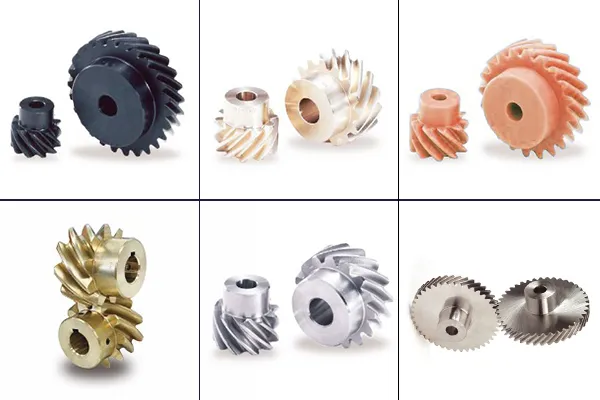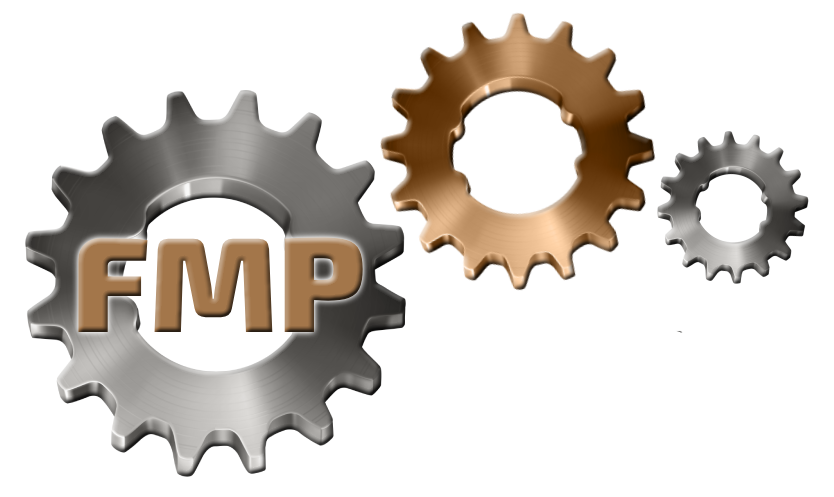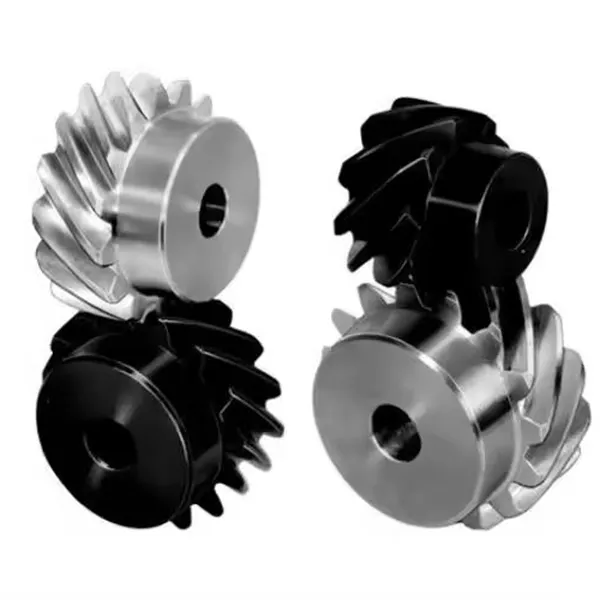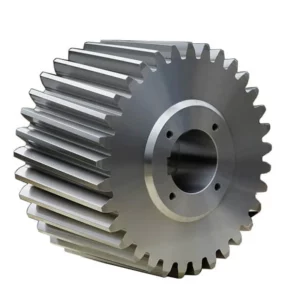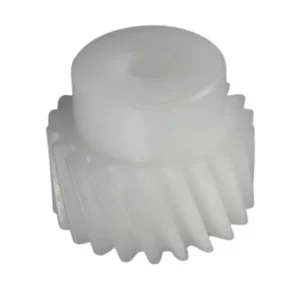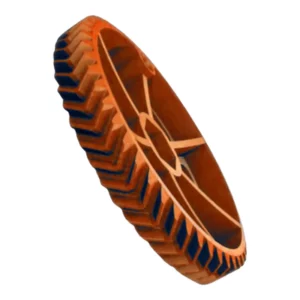Screw Gears (Crossed Helical Gears)
Screw gears, sometimes called crossed helical gears, are special gears that help move things between two shafts (like sticks that spin) that don’t touch and aren’t lined up straight. Regular helical gears for straight shafts have the same twist angle but twist in opposite ways. For screw gears, the twist angles can be whatever you need, and the angle between the shafts is usually the total of the two twist angles added together. A common angle is 90 degrees, like a corner, but other angles can work too. These gears only touch at tiny spots, not big lines, so they’re not as strong or efficient as other gears and can’t carry super heavy stuff.
What They’re Like and How They Work
- Look: Screw gears have teeth that twist around like a spiral on a round disc. The teeth can lean right or left.
- Movement: When they spin, they don’t just roll like other gears—they twist like a screw going into wood. This makes them slide against each other at small points instead of rolling smoothly.
- Speed: How fast they spin depends on how many teeth the driving gear (the one that starts it) has compared to the driven gear (the one that follows). It’s just the number of teeth on one divided by the other—no tricky rules like some other gears have!
Materials and Matching
- Stuff They’re Made Of: If both gears are the same material, they can rub too much and get scratched up. So, it’s better to use different materials, like steel with plastic or stainless steel with bronze.
- Choices: You can get them in steel (strong), stainless steel (won’t rust, good for food machines), aluminum-bronze (tough against wear), or plastic (light and doesn’t need oil).
How They Work and Where They’re Used
- Strength and Speed: They’re not the best at carrying heavy things or spinning super fast because of all the sliding. They work best for medium jobs.
- Jobs: You might find them in machines that make stuff, move things like conveyor belts, or run pumps—things that don’t need tons of power.
- Oil: Since they slide a lot, they need special oil (like hypoid gear oil) to keep them from wearing out too fast.
Good and Not-So-Good Parts
- Good Stuff: They’re quiet when they run and can be moved a bit side-to-side without messing up how they work. They’re great for shafts that cross but don’t touch.
- Not-So-Good Stuff: The sliding makes them less efficient, and they can’t handle big loads because they only touch at tiny points. They also push sideways a lot, so they need strong supports.
Types and Details
- Kinds: They come in sizes called modules 1 to 4, with 10 to 30 teeth. You can add holes or change them a bit if needed.
- Twist Angles: Often they have a 45-degree twist, and you can pair them in different ways—both twisting the same way or opposite ways—depending on how the shafts are set up.
In short, screw gears are cool for moving things between crossed shafts quietly and easily, but they’re not the strongest or fastest gears because they slide instead of roll and only touch at small spots.
Crossed Helical Gears (Screw Gears): Precision Engineering by FMP Company
Crossed helical gears, commonly known as screw gears, are a specialized type of hyperboloid gear designed for the unique purpose of mating skew shafts—axes that cross without intersecting. Unlike traditional helical gears with parallel axes, screw gears enable motion transmission between non-parallel, non-intersecting shafts, often at a 90° angle, though other configurations are possible. This makes them an essential component in mechanical systems requiring versatile shaft alignments. In Italy, where industrial innovation thrives in cities like Milan, Venice, Florence, and Bologna, the demand for high-quality screw gears is steadily rising, and FMP Company is proud to meet this need with expertly crafted solutions.

Screw gears operate with a distinctive screw motion rather than pure rolling, resulting from their differing helix angles (though with the same hand of helix). This sliding motion of the flanks, while requiring special lubrication like hypoid gear oil to minimize wear, offers unique advantages such as low-noise operation and axial flexibility. Unlike parallel helical gears, which transition from point to line contact, crossed helical gears maintain point contact, making them ideal for moderate torque and speed applications, such as drives for machine tools. Compared to worm gears, which provide higher torque through line contact, screw gears excel in quieter performance—perfect for precision industries in bustling hubs like Milan and Florence.
Specification of Crossed Helical Gear
| Model Number | M1,M1.5,M2,M2.5,M3,M4,M5,M8,M12 and etc. |
| Material | Brass, C45 steel, Stainless steel, Copper, POM, Aluminum, Alloy, and so on |
| Surface treatment | Zinc-plated, Nickel plated, Passivation, Oxidation, Anodization, Geomet, Dacromet, Black Oxide, Phosphatizing, Powder Coating, and Electrophoresis. |
| Standard | ISO, DIN, ANSI, JIS, BS and Non-standard. |
| Precision | DIN6,DIN7,DIN8,DIN9. |
| Teeth treatment | Hardened, Milled, or Ground |
| Tolerance | 0.001mm-0.01mm-0.1mm |
| Finish | shot/sandblast, heat treatment, annealing, tempering, polishing, anodizing, zinc-plated |
| Items packing | Plastic bag+Cartons Or Wooden Packing |
| Payment terms | T/T, L/C |
| Production lead time | 20 business days for the sample,25 days for the bulk |
| Samples | Sample price range from $2 to $100. sample express request paid by clients |
| Application | 1. Automatic controlling machine 2. Semiconductor industry 3. General industry machinery 4. Medical equipment 5. Solar energy equipment 6. Machine tool 7. Parking system 8. High-speed rail and aviation transportation equipment, etc. |
Types of Screw Gears(Crossed Helical Gears)
| Category | Material Composition | Module Range | Helix Angle | Teeth Count | Strength (Tensile) | Corrosion Resistance | Typical Applications |
|---|---|---|---|---|---|---|---|
| Steel Screw Gears | Carbon steel or alloy steel (e.g., AISI 1045, 4140) | 1 to 4 | 45° typical | 10 to 50+ | 500–1000 MPa | Low to Moderate | Industrial machinery, automotive systems |
| Stainless Steel Screw Gears | Stainless steel (e.g., SUS303, SUS304) | 1 to 4 | 45° typical | 10 to 50+ | 500–700 MPa | High | Food machinery, marine equipment |
| Aluminum Bronze Screw Gears | Aluminum bronze (e.g., CuAl10Fe5Ni5) | 1 to 4 | 45° typical | 10 to 50+ | 600–800 MPa | Very High | Worm drives, corrosive environments |
| Plastic Screw Gears | Nylon, Acetal, or MC Nylon | 1 to 3 | 45° typical | 10 to 40+ | 50–100 MPa | High | Light-duty systems, noise-sensitive uses |
| Metal Screw Gears | General metal (e.g., brass, cast iron) | 1 to 4 | 45° typical | 10 to 50+ | 300–800 MPa | Varies (Low to High) | General power transmission, machinery |
Notes on Specifications:
- Module Range: The module (a measure of gear tooth size) typically ranges from 1 to 4 for most screw gears, though smaller or larger modules may be available depending on the application.
- Helix Angle: Screw gears commonly use a 45° helix angle to enable non-intersecting, non-parallel shaft motion transmission, though this can vary slightly.
- Teeth Count: The number of teeth depends on the gear size and application, typically ranging from 10 to over 50.
- Strength (Tensile): Tensile strength varies by material; steel and aluminum bronze offer high strength, while plastic has lower strength but is lightweight.
- Corrosion Resistance: Stainless steel and aluminum bronze excel in corrosive environments, while carbon steel requires coatings or treatments for similar performance.
- Applications: Each material suits specific needs—steel for durability, stainless steel for hygiene, aluminum bronze for wear resistance, plastic for low noise/weight, and other metals for versatility.
This table provides helical gear specifications by category. For exact details please email us.
Why Choose FMP?
As a trusted manufacturer, FMP Company produces a diverse range of Crossed Helical Gears (Screw Gears) to suit various industrial applications. Whether you’re in Milan seeking standard models or in Venice requiring a bespoke design, we offer customization to ensure your machinery performs at its best. Our gears are engineered with precision, adhering to the highest standards of durability and efficiency. If you’re browsing our product list—whether from Florence, Bologna, or beyond—and don’t find the exact model you need, rest assured it’s likely just awaiting its debut on our catalog. Simply email us with your requirements, and our skilled engineers will respond within 24 hours with a tailored solution.
FMP Company is committed to supporting Italy’s industrial landscape with superior screw gear technology. From the fashion-forward factories of Milan to the historic craftsmanship of Florence, and from the maritime innovation of Venice to the mechanical expertise of Bologna, we’re here to power your operations with reliable, custom-engineered crossed helical gears. Contact us today to explore our offerings or inquire about a specific model—our team is ready to assist you promptly, ensuring your projects stay on track with the quality and precision you deserve.
